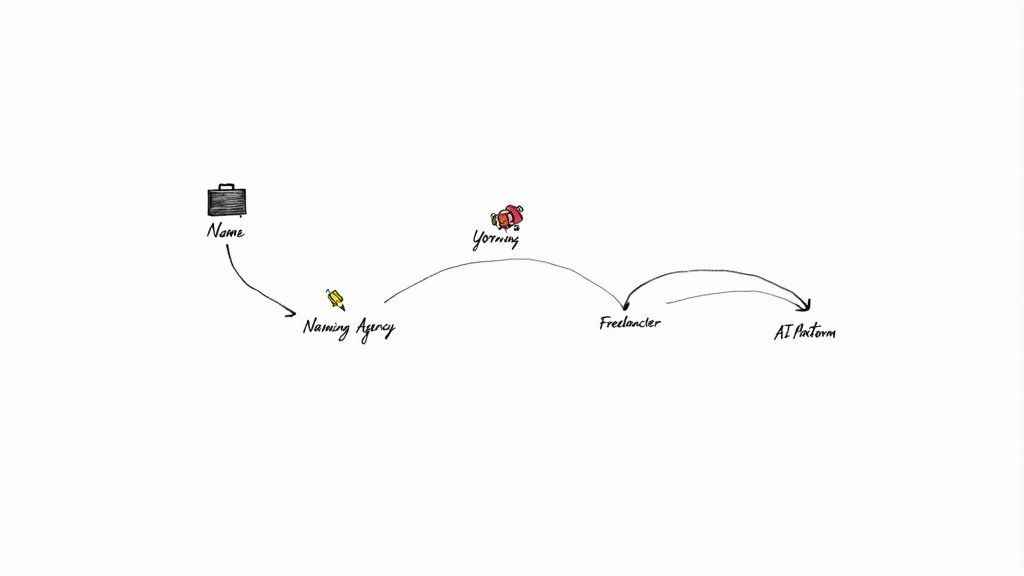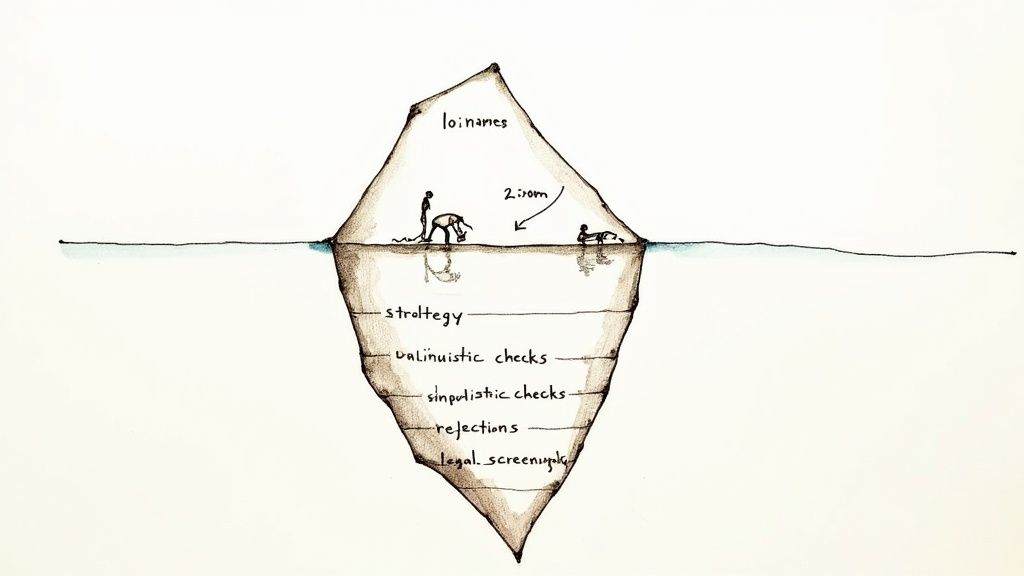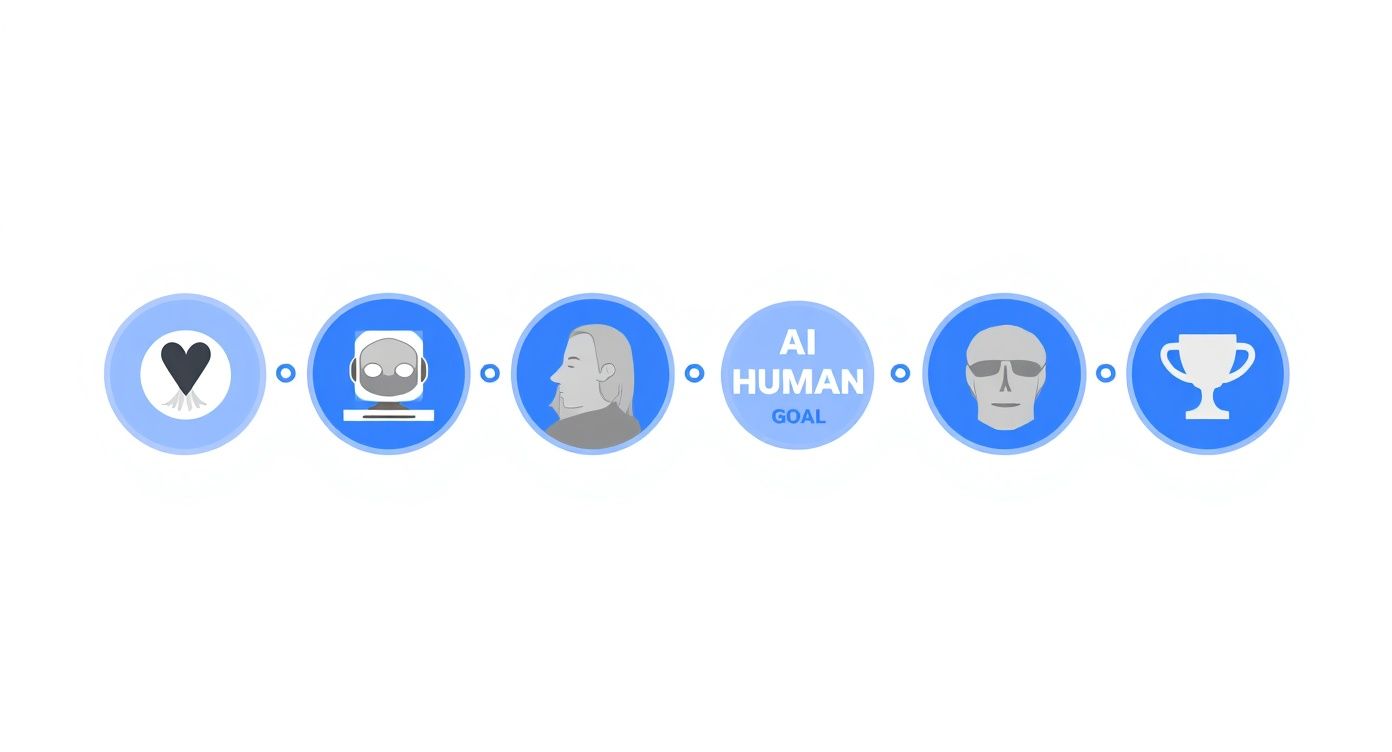Naming Agency vs. AI: A Founder's Decision Framework
Choosing a naming agency or an AI tool? This guide helps founders compare the costs, creative processes, and strategic outcomes to make the right decision.
You need a powerful brand name, and you know it's a strategic asset, not just a creative flourish. A killer name pays dividends forever. The wrong one is a long-term tax on your advertising budget.
The real question isn’t if you should invest, but how. You’re at a crossroads with three distinct paths: hire a traditional naming agency, contract a proven freelancer, or leverage a modern AI-powered platform. Each path offers a different blend of cost, speed, strategic depth, and creative control. This guide is a framework for making the right choice.
If you already know the power of a strategic approach and want to see how AI can accelerate it, you can.
The Three Paths to a Brand Name: Agency, Freelancer, AI

Choosing your naming partner is a strategic decision. It's a trade-off between budget, timeline, and the level of strategic partnership you require. The right path depends on your company's stage, funding, and risk tolerance.
A top-tier naming agency offers a deep, collaborative process, pouring hundreds of hours into brand strategy, linguistic analysis, and legal screening.
An expert freelancer provides focused, senior-level expertise without the agency overhead.
An AI platform delivers massive scale and speed, automating the heavy lifting so you can focus on strategy.
Why This Decision Matters More Than Ever
We live in a crowded, digital-first world where your name is your first impression. According to recent current branding stats, a consistent brand presentation can increase revenue by up to 33%. That consistency starts with a name that is distinct, memorable, and legally defensible. This guide provides the decision criteria to compare your options without the fluff.
Key Takeaways
Strategy Before Creativity: A great name is the output of a rigorous strategic process, not a random brainstorming session.
The "Hidden Work" is Critical: Behind every great name are hundreds of hours of research, linguistic checks, and legal screening. This is what you pay for.
AI Automates the Grind, Not the Judgment: AI platforms excel at generating thousands of ideas and performing initial checks, compressing weeks of work into minutes. Human intuition is still required for the final strategic choice.
The Hybrid Model Wins: The most effective modern approach combines AI's scale and speed with human strategic oversight.
Comparing Your Naming Options at a Glance
Factor | Naming Agency | Expert Freelancer | AI Naming Platform |
|---|---|---|---|
Cost | $5,000 - $10,000+ | $500 - $5,000 | $19 - $500 |
Speed | 4-12 weeks | 2-6 weeks | Minutes to hours |
Strategic Depth | Very high (team-based research) | Moderate to high (individual expertise) | User-driven (relies on your brief) |
Creative Volume | Highly curated shortlist (5-10 names) | Focused list (10-30 names) | Massive scale (1000s of ideas) |
Best For | Enterprise, well-funded startups | Startups with clear briefs, rebrands | Bootstrappers, early-stage founders |
This table frames the core trade-offs. Now let's dive into the invisible work that separates a professional name from a placeholder.
The Hidden Work Behind Every Naming Agency Pitch

When a naming agency presents a clean slide deck with ten elegant name options, it looks effortless. That’s the point. But behind that moment are hundreds of hours of invisible work: research, semantics, linguistic mapping, and thousands of rejected ideas. That methodical grind is what you pay for. It’s a process built to de-risk one of your most important brand assets.
The Traditional Agency Playbook: Strategy Before Creativity
A naming team doesn’t start with words; they start with strategy. Before a single name is generated, they execute a meticulous workflow.
The Naming Brief Framework
A professional brief is the foundation. It’s not a quick form; it’s a strategic document.
Positioning: Who are we, and what space do we uniquely own?
Audience: Who are we talking to? What do they value?
Emotional Goal: How do we want people to feel when they hear our name? (e.g., Secure, Innovative, Empowered)
Functional Criteria: What must the name do? (e.g., Hint at the category, be easy to spell, work globally)
Once the strategy is locked, the hidden work begins:
Define Meaning Territories: They map conceptual areas where the name could live. For a sustainable brand, territories might include "Nature," "Renewal," "Circular Tech," or "Simplicity."
Generate Volume: Every round produces 1,000–2,000 words and combinations. This isn't just brainstorming; it's systematic exploration using linguistic techniques.
Ruthless Screening: This is where 99% of ideas die. Names are filtered for:
Linguistic Issues: Negative connotations, awkward phonetics, misinterpretations in other languages.
Domain Availability: Is the .com (or relevant TLD) available?
Trademark Pre-screening: A preliminary search to flag obvious conflicts in your class.
This exhaustive, human-powered process is designed to deliver names that aren't just clever, but strategically sound and legally protectable.
Caselet: From Generic to Defensible
A B2B SaaS company helping logistics firms optimize delivery routes used the working name "RouteOptima." It's descriptive but forgettable and sounds like every competitor ("OptiRoute," "RouteLogic").
The Problem: Zero distinctiveness, no emotional hook, and difficult to trademark.
The Process: An agency defined territories like "Flow," "Precision," and "Nexus." They generated over 1,500 candidates, screening them for memorability, domain availability, and trademark conflicts.
The Result: "Vecteris"—a coined name blending "vector" (direction, magnitude) with a sophisticated suffix. It feels technical yet elegant, is highly protectable, and gives the brand a unique story.
That outcome doesn't happen by chance; it requires a structured methodology. You can learn more about the full agency naming process.
How AI Compresses the Naming Process
The traditional agency process is robust but slow and expensive. This is where AI flips the script. Tools like automate the heavy, repetitive part—the grunt work of creativity.
AI doesn't replace strategy; it accelerates it. It takes the weeks of manual labor involved in volume generation and initial screening and compresses it into minutes.
What AI Now Does Brilliantly
Modern naming platforms are force multipliers for creativity. They can:
Analyze Your Brief in Seconds: AI processes your strategic input, audience profile, and desired emotional tone to define relevant naming territories instantly.
Generate Naming Fields at Scale: It can generate thousands of linguistically relevant options across multiple dictionaries and conceptual fields—far more than a human team could brainstorm.
Score and Screen Instantly: The platform can score thousands of words by tone and emotional weight, while simultaneously checking domains and preliminary trademark databases. All the dead-ends are filtered out before you see them.
This changes the game. Founders can jump straight to the high-value work: evaluating strategically-aligned options instead of waiting weeks for a shortlist. Want to see this in action? Here's how to use a business name generator effectively.
What Humans Still Do Better
But the hardest part—the judgment—remains human. Only a person can sense rhythm, irony, warmth, and that intangible rightness when a name just fits.
Humans understand brand archetypes, cultural nuance, and emotional subtext. AI can propose 2,000 names—but it can’t yet care which one tells your story. That’s why the future of naming isn’t about replacing agencies; it’s about compressing their process.
The new creative model is humans guiding AI. AI handles the depth and data. Humans bring the taste, intuition, and storytelling that make a name feel inevitable.
Pitfalls to Avoid in Your Naming Process
Regardless of the path you choose, experienced founders often stumble into the same traps. Here’s how to sidestep them.
The "I'll Know It When I See It" Fallacy.
The Pitfall: Starting the creative process without a clear strategic brief. This leads to subjective feedback loops and wasted time.
How to Avoid It: Lock down your naming brief first. Define your positioning, audience, and emotional goal. No creative work begins until the strategy is agreed upon.
Falling in Love Too Early.
The Pitfall: Getting emotionally attached to a name before it has been properly vetted for trademark conflicts or negative connotations.
How to Avoid It: Treat all early names as candidates, not finalists. The rule is simple: a name isn't real until it has passed legal screening.
Designing by Committee.
The Pitfall: Asking everyone in the company for their opinion. A great name is often distinctive and unfamiliar at first, making it an easy target for criticism.
How to Avoid It: Keep the decision-making circle small (2-3 key stakeholders). Use the strategic brief, not personal taste, as the objective measure for evaluating names.
Mistaking a Trademark Search for Legal Advice.
The Pitfall: Running a quick search on the USPTO website and assuming you're in the clear. Trademark law is complex and nuanced.
How to Avoid It: Use AI tools for preliminary screening to weed out obvious conflicts. But before you commit and invest, hire a trademark attorney to conduct a comprehensive search and provide a legal opinion.
A Decision Framework for Choosing Your Path
So, which path is right for you? Your decision should be based on four key factors: budget, timeline, strategic depth, and risk tolerance.
Core Decision Criteria Checklist
Use this checklist to clarify your needs:
Budget: What is our absolute maximum investment for the name itself (excluding legal fees)?
[ ]< $1,000 (Path: AI Platform)[ ]$5,000 - $25,000 (Path: Freelancer or Hybrid)[ ]$25,000+ (Path: Naming Agency)
Timeline: When do we need a legally cleared, final name?
[ ]< 2 weeks (Path: AI Platform)[ ]2-6 weeks (Path: Freelancer)[ ]2-4 months (Path: Naming Agency)
Strategic Need: How developed is our brand strategy?
[ ]We need a partner to help define our strategy from the ground up. (Path: Naming Agency)[ ]We have a clear strategy and need expert creative execution. (Path: Freelancer)[ ]We have a clear strategy and want to lead the creative exploration ourselves. (Path: AI Platform)
Risk Tolerance: How much of the legal and linguistic screening process are we equipped to manage?
[ ]We need a full-service partner to manage all risk. (Path: Naming Agency)[ ]We can manage the final legal check but need professional pre-screening. (Path: Freelancer / AI)[ ]We are comfortable managing the entire legal vetting process ourselves. (Path: AI Platform)
Don't underestimate the impact of this choice. Research on how brand names influence consumer behavior shows that distinctiveness is directly linked to memorability and trust.

Pros and Cons: Naming Agency vs. Freelancer vs. AI
Criteria | Naming Agency | Expert Freelancer | AI Naming Platform |
|---|---|---|---|
Strategic Depth | Pro: Deep, integrated brand strategy. | Pro: Focused, senior-level expertise. | Pro: User-driven strategy at scale. |
Creative Scope | Pro: Highly curated, vetted options. | Pro: Good balance of curation and volume. | Pro: Massive, unparalleled creative volume. |
Legal Rigor | Pro: Extensive trademark screening. | Pro: Basic screening is often included. | Pro: Instant pre-screening for availability. |
A founder who needs a strategic partner to manage every detail will find value in a naming agency. Another with a clear brief who needs focused creative firepower is a perfect fit for a freelancer. And for the founder who wants to drive the process and explore thousands of avenues quickly and affordably, an AI platform like Nameworm is the clear choice.
Your Next Steps
Whether you partner with a naming agency, hire a freelancer, or use an AI platform, the goal is the same: find a name that is a genuine strategic asset. The smartest modern approach combines AI's data-crunching power with irreplaceable human judgment. This hybrid model delivers the best of both worlds: massive creative exploration guided by focused, strategic intuition.
Next Steps Checklist
Finalize Your Naming Brief. Use the framework above (Positioning, Audience, Emotion, Function). This document is your North Star.
Set Your Budget and Timeline. This single step will immediately narrow your path.
Explore Creatively with an AI Tool. Use to generate hundreds of ideas based on your brief. This is the fastest way to map the creative territory and discover what resonates.
Create a Shortlist. Select your top 5-10 candidates that align with the brief.
Conduct Comprehensive Legal Screening. Before you commit, understand if you need to trademark your business name and engage a lawyer to ensure your top choice is defensible.
Ready to combine AI-driven scale with your strategic vision? Nameworm helps you find a powerful, protectable name without the agency price tag or timeline. Start your naming journey with Nameworm today.